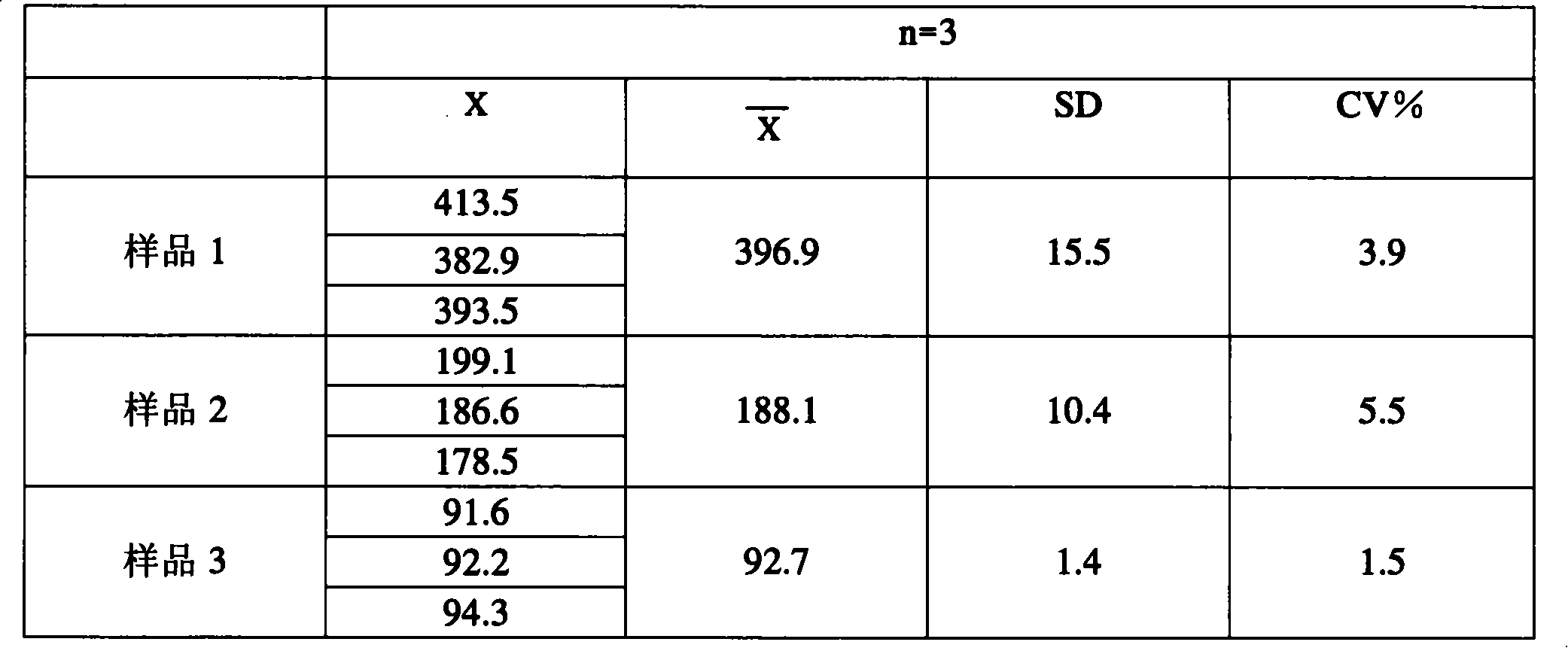Method for preparing polyclonal antibody against mouse nerve growth factor (NGF) and application thereof
A technology of nerve growth factor and polyclonal antibody, which is applied to the preparation method of peptides, anti-growth factor immunoglobulin, chemical instruments and methods, etc., and can solve the problems of difficulty in obtaining antibodies and weak immunogenicity
- Summary
- Abstract
- Description
- Claims
- Application Information
AI Technical Summary
Problems solved by technology
Method used
Image
Examples
Embodiment 1
[0052] The preparation of embodiment 1 polyclonal antibody
[0053] preparation
[0054] 1. The purified NGF was polymerized with glutaraldehyde at 150 μg / rat, fully mixed with an equal volume of complete Freund’s adjuvant, emulsified, and subcutaneously injected into normal rabbits at multiple points;
[0055] 2. One month later, the same amount of antigen was fully mixed and emulsified with incomplete Freund's adjuvant, and subcutaneously injected again at multiple points;
[0056] 3. After one month, repeat step 2;
[0057] 4. Ear blood was collected one week after the last immunization, and the titer was measured by indirect ELISA method, which should be greater than 1:1000;
[0058] 5. Blood was collected from the ear vein, 50ml / time, twice, and the serum was collected and stored at -20°C.
Embodiment 2
[0059] The purification of embodiment 2 polyclonal antibody
[0060] 1. Preparation of antigen affinity column: the purified antigen (mouse submandibular gland nerve growth factor NGF) was dialyzed in coupling buffer (0.1mol / L NaHCO 3 , 0.5mol / LNaCl, pH8.3), the CNBr-activated sepharose 4fast flow gel was washed several times with pre-cooled 0.5mM~50mM HCl, negative pressure ultrafiltered, and replaced in the coupling buffer; the antigen was combined with the activated The micelles were mixed and stirred overnight at 4°C; the incompletely bound antigen was washed with coupling buffer; the blocking buffer (0.2mol / L glycine) was reacted at room temperature for more than 0.5 hours to block the activation site that was not saturated by the antigen; coupling buffer and acetate buffer 0.1mol / LCH 3 COO·Na and 0.5mol / L NaCl, pH 4.0) were washed alternately for more than 2 times, and the micelle coupled with the antigen was stored in 20% alcohol.
[0061] 2. Binding buffer (PBS) full...
Embodiment 3
[0066] Embodiment 3 ammonium sulfate-n-octanoic acid method purification method:
[0067] Take a certain volume of serum, dilute 2 times or 4 times with 0.06mol / L pH4.8 HAc-NaAc buffer; add n-octanoic acid dropwise to make the final concentration 75μl / ml (n-octanoic acid / rabbit serum), and stir 30min, centrifuge at 12000r / min at room temperature for 20min and take the supernatant; add 0.1mol / L PBS solution with pH7.4 whose volume is 1 / 10 of the supernatant, let stand for 2 hours or overnight at 4°C; centrifuge at 12000r / min at 4°C for 30min , discard the supernatant; dissolve the precipitate in a certain volume of 0.01mol / LpH7.4 PBS, dialyze overnight at 4°C with 50-100 times the volume of 0.01mol / LpH7.4 PBS.
PUM
 Login to View More
Login to View More Abstract
Description
Claims
Application Information
 Login to View More
Login to View More - R&D
- Intellectual Property
- Life Sciences
- Materials
- Tech Scout
- Unparalleled Data Quality
- Higher Quality Content
- 60% Fewer Hallucinations
Browse by: Latest US Patents, China's latest patents, Technical Efficacy Thesaurus, Application Domain, Technology Topic, Popular Technical Reports.
© 2025 PatSnap. All rights reserved.Legal|Privacy policy|Modern Slavery Act Transparency Statement|Sitemap|About US| Contact US: help@patsnap.com

